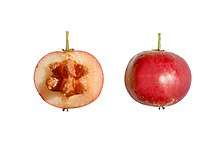Flacourtia jangomas
Flacourtia jangomas, Indian coffee plum, Scramberry is a lowland and mountain rain forest tree in the Salicaceae or Willow Family.[1][2] It is widely cultivated in Southeast and East Asia, and has escaped cultivation in a number of places.[3] Its wild origin is unknown but is speculated to be tropical Asia, most perhaps India.[3][4] This tree is very common in the Southern India and carries immense culinary and medical significance, especially in Kerala where it is commonly known as lubica or lovlolika.[5] Fruits are eaten both raw and cooked as a jam, and the bark is sometimes used medicinally.[1][2] It is sometimes harvested for its lumber. The plant is considered one of the primary host plants of the Queensland fruit fly (Bactrocera tryoni)[6]
| Wikimedia Commons has media related to Flacourtia jangomas. |
| Flacourtia jangomas | |
|---|---|
.jpg) | |
| Lubika | |
 | |
| Lubika cross section | |
| Scientific classification | |
| Kingdom: | |
| (unranked): | |
| (unranked): | |
| (unranked): | |
| Order: | |
| Family: | |
| Tribe: | Flacourtieae |
| Genus: | |
| Species: | F. jangomas |
| Binomial name | |
| Flacourtia jangomas (Lour.) Raeusch. | |
| Synonyms | |
|
Flacourtia cataphracta Roxburgh ex Willdenow. | |
Description
Flacourtia jangomas is a small, deciduous shrub or tree that grows to a height of 6-10m. Trunk and branches are commonly thornless in old trees, but densely beset with simple or branched, blunt woody thorns when younger. Bark is light-brown to copper-red with a flaky texture and the leaves are light green and narrow ovate in shape. It produces small white to whitish green fragrant flowers. The relatively juicy fruits are rounded pink to dark red and about an inch wide.[7]
Common names
- Bengali: ŧipa fol
- Assamese: poniol (পনিয়ল)
- English: Indian coffee plum, Indian sour cherry, rukam, runeala plum, scramberry
- Hindi: talispatri (तालिसपत्री), Pani amla (पानी आमला)
- Manipuri: heitroi ( হৈত্ৰোঈ )
- Thai: takhob
- Rohingya, Chittagonian: fainná gula
- Sanskrit: sruvavrksha, vikankatah (स्रुववृक्ष)
- Sylheti: lukluki (ꠟꠥꠇꠟꠥꠇꠤ), kulkuli (ꠇꠥꠟꠇꠥꠟꠤ)
- Malayalam: lubica, lovlolika (ലൂബിക്ക), vayyamkaitha (ലൗലോലിക്ക)
- Tamil: vaiyyankarai
- Mizo: Sakhi Thei
- Malay: Buah Kerkut
Uses
Food
Flacourtia jangomas fruits are widely eaten around South Asia, both raw and cooked. They are noted for their mild sour and tangy taste. The fruits are pickled, salt-dried or cooked in Indian curries. They can also be blended into juices or made into jams and marmalades which are immensely popular in Southern India. Commercially produced Coffee plum jams and pickles are exported across the world by various companies, mainly from Kerala.
Medicine
In South Asian folkloric medicine, the fruits and leaves of Indian coffee plum are used against diarrhea. Dried leaves are reportedly effective for bronchitis and roots are said to suppress toothache. The bark of Flacourtia jangomas has various antifungal and antibacterial constituents which makes it an important ingredient for a few Ayurvedic drugs.[1][2] Ground bark paste is also used for curing many common ailments in the tribal settlements of Western Ghat.
Lumber
The wood is sometimes harvested for lumber in the Indian states of Tamil Nadu, Kerala and Karnataka. It is often used as a cheaper alternative to Teak and other expensive wood.
References
- Hanelt, Peter; Institute of Plant Genetics and Crop Plant Research, eds. (2001). Mansfeld's Encyclopedia of Agricultural and Horticultural Crops: (Except Ornamentals). Springer. p. 3700. ISBN 978-3-540-41017-1.
- Chandra, Indrani; P. Bhanja (2002-08-25). "Study of organogenesis in vitro from callus tissue of Flacourtia jangomas (Lour.) Raeusch through scanning electron microscopy". Current Science. India: Current Science Association and Indian Academy of Sciences. 83 (4): 476–479.
- Flacourtia jangomas (Lour.) Raeuschel, Pacific Island Ecosystems at Risk (PIER)
- "Flacourtia jangomas". Germplasm Resources Information Network (GRIN). Agricultural Research Service (ARS), United States Department of Agriculture (USDA). Retrieved 19 January 2018.
- George Shibumon and Benny P J (2010) “Antifungal activity of acetonic extract of Flacourtia inermis fruit against human opportunistic pathogens” Journal of Global Pharma Technology. 2(6):28-34.
- Botha, John; Darryl Hardie; Greg Power (2000). "Queensland fruit fly Bactrocera tryoni: Exotic threat to Western Australia" (PDF). AGWEST Factsheet. The Government of Western Australia. Archived from the original (pdf) on 2008-09-01. Retrieved 2008-12-29.
- Thingnam, Sophia. "Flacourtia jangomas- Description". Flowers Of India. Retrieved 9 August 2016.